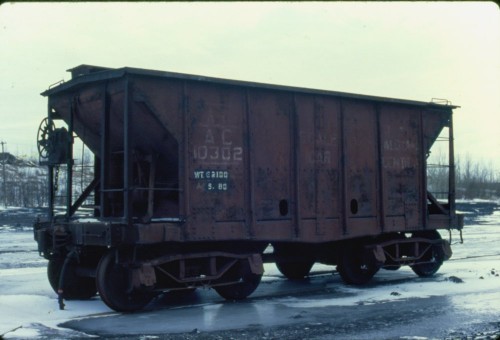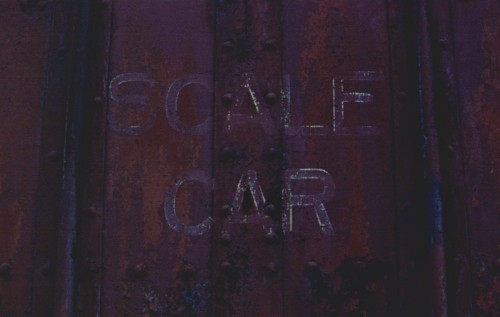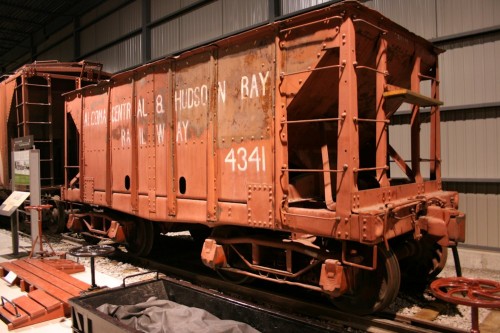In the early 1980s, the Algoma Central rostered a single scale test car, for testing the calibration of track weigh scales, that was also a historical artifact from the earliest days of the railway.
Scale test car AC 10302 was originally built new in 1901 for the Algoma Central Railway as an ore hopper in series AC 4201-4399 (odd numbered only) and is the only remaining survivor of the original fleet that served the iron ore mines of the Wawa range at the beginning of the 20th century.
This ancient car was pretty much celebrating its 80th birthday when photographed in active service at Wawa in March 1981 (photographer unknown, my collection), present to test the calibration of the local scale. Amazingly, this car still survives to this day, its existence having been discovered by members of the Canadian Historical Railway Association in the 1980s and acquired for preservation at the Canadian Railway Museum/ExpoRail in St.-Constant, Quebec as an extremely early example of an all steel hopper car. While restoring the car, volunteers actually managed to find traces of the previous Algoma Central & Hudson Bay Railway lettering, and this was recreated and restored.
(Above photo at ExpoRail in St-Constant, QC., courtesy of Michael Eby.)
Roster information is a little spotty for the early years, but there appear to have been 200 such cars built in 1900-1901 for the AC/AC&HB, and another 100 were acquired second-hand in 1916 from the Duluth & Iron Range Railroad in Minnesota. They seem to have been eliminated from the roster by the early 1930s.
Based on the best information available, the following roster information is compiled:
| Series | Qty. | Build Date | Notes |
|---|---|---|---|
| (Original Series 1900-1904): | |||
| 3101-3150* | 50 | 1900 | re# 4001-4050 /1904 |
| 3151-3200* | 50 | 1900 | re# 4051-4100 /1904 |
| 4201-4399 (odd) | 100 | 1901 | re# 4101-4200 /1904 |
| (Secondary Numbers 1904-1933): | |||
| 3901-4000 | 100 | 1901 | ex-D&IR 3050-3399 series /1916 |
| 4001-4050 | 50 | 1900 | ex-3101-3150* /1904 |
| 4051-4100 | 50 | 1900 | ex-3151-3200* /1904 |
| 4101-4200 | 100 | 1901 | ex-4201-4399 /1904 |
Some questions and a lot of unknowns still exist here though as some sources list the original two 1900 groups as AC 3001-3099 and 3101-3199 (both groups odd numbers only) instead of the AC 3101-3200 (unbroken) series I used above, but a builder’s photo exists which shows car ACR 3200, which is not accounted for under the apparent odd-numbers only numbering scheme suggested for the original cars. The next year in 1901 another 100 cars were acquired numbered AC (or AC&HB) 4201-4399 (odd numbers only). The entire mess was renumbered around 1903-04 to AC&HB 4001-4200 (unbroken) to clear up the jumbled numbers. Another 100 cars acquired secondhand in 1916 from the Duluth & Iron Range Railroad were slotted directly under the existing cars as ACR 3901-4000.
The ACR 3200 builder’s photo also shows a completely different style of lettering than the restored lettering on AC&HB 4341 above (and displaying the railway’s original name as only “Algoma Central Railway”, not the later “Algoma Central & Hudson Bay Railway”); and Dale Wilson’s newest book “More Black Bear Tracks” has a 1917 photo of ACR 3903, one of the ex-D&IR cars, with a simplified paint job with only “ACR” initials and basic car data.
These ore hoppers were primarily used to transport iron ore from Algoma Steel’s Helen, Magpie and Josephine mines in the Michipicoten Iron Range around what is today the Wawa area to the ore dock at Michipicoten harbour. However the last of these mines shut down in the early 1920s and Helen Mine wouldn’t be redeveloped until nearly two decades later in 1939 at which point a “new” fleet of secondhand twin hoppers from various American roads was acquired to handle this service, making it all the more amazing such a relic ever survived.



